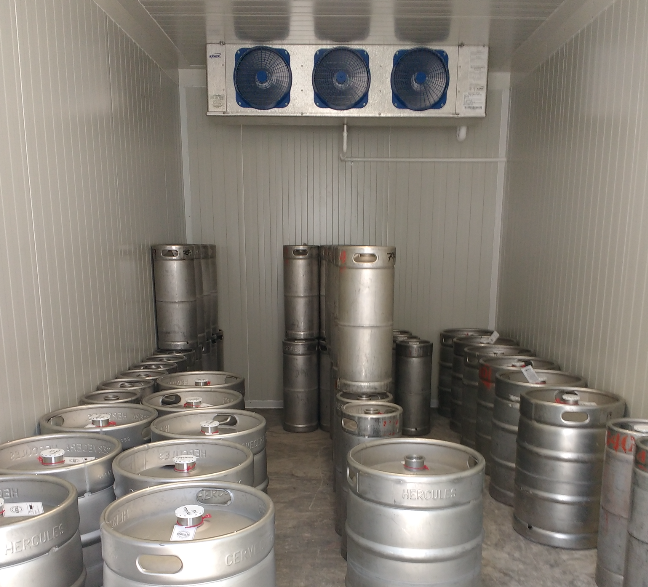When you and your company have reached the decision to install a cold room, or a cooling chamber, you need to bear in mind a series of factors for your facility to work properly, and to stand the test of time.
Cold room design goes hand-in-hand with your business features and the goals set out for food, and industrial or medical preservation and function.
Outlining the right cooling requirements
A cooling expert must compile your company's needs in order to tailor solutions which primarily consider:
1. Cooling goals as pertains your industry
Product number, capacity, and so on. Among the uses given to cooling chambers are:
- Frozen product storage
- Cooled product storage
- Blast freezing
- Processing room
- Fruit or vegetable pre-cooling
- Fruit ripening
- Beef or cheese aging
- Wine storage
- Convenience store
- Medical tests or products
- Industrial material preservation
2. Power saving
Or how to use a cold room or cooling chamber in such a way, it helps keep low-energy consumption as much as possible.
3. In-force ecological regulations
There are cooling processes and pieces of equipment that resort to cooling gases which seriously harm the environment. This is why your cold room must be tailored to fit the regulations, at the risk of assuming the costs and the resulting environmental fines.
Today, a lot of companies are considering this not only because it is required, but because it allows them to considerably reduce their energy expenses.
Do you know the eco-friendly natural cooling gases?
- Carbon dioxide (Co2), or R-744: low-damaging to the ozone layer, it's a gas commonly used in the automotive industry.
- Ammonia (NH3), or R-717: a cooling gas primarily used in industries. It can be used either on new equipment or on already-existing one.
- Hydrocarbon (HC)-based cooling agents. A3-ranked cooling agents, i.e. flammable gas-based. Its use calls for a number of precautions, among which we can find the deep knowledge needed on the particular cooling agent. These are applied to several small-scale cooling systems.
Do you know what the synthetic cooling agents, which are soon to disappear, are?
These are like the following:
- Hydrofluorocarbons (HFCs)
- Hydrochlorofluorocarbons (HCFCs)
- Chlorofluorocarbons (CFCs)
- It's well known that these chemical agents are environmentally harmful, especially for the ozone layer and the consequent greenhouse effect and global warming. Their use is strictly controlled and seldom is it used.
Important factor when designing a cold room
Besides the aforementioned general features, a cooling expert must take into consideration your daily operations when designing your cold room.
Your daily company logistics defines the number of times a product gets in and out of the cooling chamber, the number of people having access to it, and the length of their stay. This means that temperature fluctuations need to be considered as pertains the heat flow in the cooling needs.
For example, the temperature fluctuations resulting from an open door or window, and the heat signatures from people working inside the cold room, all need to be considered.
Likewise, in smaller-scale businesses calling for cooling display counters, the number of times the counter is opened, or how many times the products are being moved, affect the heat flow.
This is a fundamental component which the cooling expert must consider in order to provide cooling equipment which is viable, cost-effective, and complying with the regulations.
Cold-room needs and components
It's important to watch over all stages of your project: design, cooling equipment, control engineering and valves, and the right heat exchangers matching the cooling agent, among other things.
On the other hand, a cooling expert must list down the following:
- Cold-room dimensions
- Type of product to be preserved
- How does the product enter the cold room?
- Cooling gas choice
With this information, you can start designing your ideal cold room, considering product use and inflow and thus keep the equipment under optimal conditions.
Some of the basic components to a cooling chamber are:
- Access door
- Glass door
- Tailormade panels
- Finishing details
- Condensing Unit
- Evaporator
- Valves
These are all requirements for a cold room.
However, depending on either the mechanical system to be implemented, i.e. direct expansion or fluid recirculation, or the cooling agent, i.e. halocarbons, ammonia, carbon dioxide, etc., the pipeline, valve, and heat exchanger specs will vary.
Common mistakes when setting up cooling equipment
The most common mistakes when installing or designing cold rooms, which are surprisingly pretty frequent, are:
- Use of non-insulating material, such as non-PUR bricks or panels in the ceiling or walls.
- Cold rooms or cooling chambers with very narrow dimensions which hinder the room for maneuver and product storage.
- Poor equipment design or choice regarding the product to be preserved and/or stored.
- Cooling chambers without a suitable access system, which results in high temperature fluctuations potentially product-harmful.
- Today, keeping your products which make your business run is a need to be met by all possible means in order to comply with QA, savings and ecofriendly expectations.
A first step consists in outlining the pre-installation requirements in order to ensure the correct performance and service life of the ideal cold room for your business.
The time invested, and the information provided to the designer in charge of your strategic preservation tool, will be translated into business profitability, growth, and consolidation. In no event should this decision be made lightly.
Related
Discover more related articles

Key aspects on ROI for industrial refrigeration projects
Marketing industrial refrigeration projects entails a series of challenges in communication between the company and the client.
The return of...
Read more »

%2015.52.54.png?width=600&name=Captura%20de%20pantalla%202018-08-28%20a%20la(s)%2015.52.54.png)
